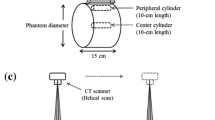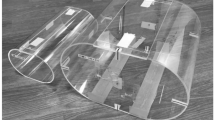Abstract
In this study, we proposed and evaluated the validity of an optimized size-specific dose estimate, a widely used index of radiation dose in X-ray computed tomography (CT) examinations. Based on miscentering correction of scout images, we determined the appropriate conversion factors (CF) by using a phantom. Scans were conducted using a multi-detector CT system (Aquilion ONE, Canon Medical Systems). Four cylindrical phantoms were taken in the anteroposterior (AP) and axial directions to determine the relationship between pixel value and water-equivalent length (Lw). In the AP scout image, the pixel values at the selected slice positions were converted to Lw to calculate the water-equivalent diameter (Dw). The CF was derived from Dw and CF values before and after miscentering correction was calculated. Finally, the CF values were compared to those calculated from the axial image using the conventional methodology of the American Association of Physicists in Medicine. Before miscentering correction, the maximum difference between the CF values of the axial and scout images was 7.26%. However, after miscentering correction, the maximum difference was 1.34%. Validation using a whole-body phantom generally revealed low maximum differences between the CF from the axial image and the values from the miscentering-corrected scout images. These were 2.41% in the chest, 6.30% in the upper abdomen, 1.43% in the abdomen, and 2.45% in the pelvic region. Consequently, we concluded that our miscentering correction method for deriving the appropriate CF values based on scout images is advantageous.







Similar content being viewed by others
References
McCollough CH, Leng S, Yu L, Cody DD, Boone JM, et al. CT dose index and patient dose: they are not the same thing. Radiology. 2011;259:311–6.
American Association of Physicists in Medicine. Size-specific dose estimates (SSDE) in pediatric and adult body CT examinations. Report of AAPM Task Group 204, 2011.
Kidoh M, Utsunomiya D, Oda S, Nakamura T, et al. Breast dose reduction for chest CT by modifying the scanning parameters based on the pre-scan size-specific dose estimate (SSDE). Eur Radiol. 2017;27:2267–74.
Kawashima H, Ichikawa K, Hanaoka S, et al. Relationship between size-specific dose estimates and image quality in computed tomography depending on patient size. J Appl Clin Med Phys. 2018;19(4):246–51.
Iriuchizima A, Fukushima Y, Nakajima T, et al. Simple method of size-specific dose estimates calculation from patient weight on computed tomography. Radiat Prot Dosim. 2018;178:208–12.
Karmazyn B, Ai H, Klahr P, Ouyang F, Jennings SG. How accurate is size-specific dose estimate in pediatric body CT examinations? Pediatr Radiol. 2016;46:1234–40.
Imai R, Miyazaki O, Horiuchi T, Kurosawa H, et al. Local diagnostic reference level based on size-specific dose estimates: assessment of pediatric abdominal/pelvic computed tomography at a Japanese national children’s hospital. Pediatr Radiol. 2015;45:345–53.
Wang J, Duan X, Christner JA, Leng S, Yu L, et al. Attenuation based estimation of patient size for the purpose of size specific dose estimation in CT: Part I. development and validation of methods using the CT image. Med Phys. 2012;39:6764–71.
Wang J, Duan X, Christner JA, Leng S, Yu L, et al. Attenuation based estimation of patient size for the purpose of size specific dose estimation in CT: Part II. Implementation on abdomen and thorax phantoms using cross sectional CT images and scanned projection radiograph images. Med Phys. 2012;39:6772–8.
McCollough C, Bakalyar DM, Bostani M, Brady S, et al. Use of water equivalent diameter for calculating patient size and size-specific dose estimates (SSDE) in CT. Report of AAPM Task Group 220, 2014.
Li B, Behrman RH, Norbash AM. Comparison of topogram-based body size indices for CT dose consideration and scan protocol optimization. Med Phys. 2012;39:3456–65.
Anam C, Fujibuchi T, Toyoda T, Sato N, et al. A simple method for calibrating pixel values of the CT localizer radiograph for calculating water-equivalent diameter and size-specific dose estimate. Radiat Prot Dosim. 2018;179:158–68.
Zhang D, Mihai G, Barbaras LG, Brook OR, et al. A new method for CT dose estimation by determining patient water equivalent diameter from localizer radiographs geometric transformation and calibration. Med Phys. 2018;45:3371–8.
Koyanagi Y. The reduction of radiation exposure from ct examinations. Jpn J Occup Med Traumatol. 2015;63(4):219–24.
Acknowledgements
The authors thank Dr. Jared Boasen, Research Associate of Faculty of Health Sciences in Hokkaido University, for correcting our English expressions.
Author information
Authors and Affiliations
Corresponding author
Ethics declarations
Conflict of interest
The authors declare that they have no conflict of interest.
Ethical approval
The article does not contain any studies with human participants or animals performed by any of the authors.
Additional information
Publisher's Note
Springer Nature remains neutral with regard to jurisdictional claims in published maps and institutional affiliations.
About this article
Cite this article
Terashima, M., Mizonobe, K. & Date, H. Determination of appropriate conversion factors for calculating size-specific dose estimates based on X-ray CT scout images after miscentering correction. Radiol Phys Technol 12, 283–289 (2019). https://doi.org/10.1007/s12194-019-00519-5
Received:
Revised:
Accepted:
Published:
Issue Date:
DOI: https://doi.org/10.1007/s12194-019-00519-5




